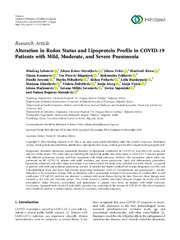Приказ основних података о документу
Alteration in Redox Status and Lipoprotein Profile in COVID-19 Patients with Mild, Moderate, and Severe Pneumonia
| dc.creator | Lalosević, Miodrag | |
| dc.creator | Kotur-Stevuljević, Jelena | |
| dc.creator | Vekić, Jelena | |
| dc.creator | Rizzo, Manfredi | |
| dc.creator | Kosanović, Tijana | |
| dc.creator | Blagojević-Perović, Ivana | |
| dc.creator | Zeljković, Aleksandra | |
| dc.creator | Jeremić, Danilo | |
| dc.creator | Mihajlović, Marija | |
| dc.creator | Petković, Aleksa | |
| dc.creator | Hajdarpasić, Lejla | |
| dc.creator | Đorđević, Marjana | |
| dc.creator | Dobrilović, Violeta | |
| dc.creator | Erceg, Sanja | |
| dc.creator | Vujčić, Sanja | |
| dc.creator | Marjanović, Jelena | |
| dc.creator | Jovanović-Milijić, Jovana | |
| dc.creator | Saponjski, Jovica | |
| dc.creator | Bogavac-Stanojević, Nataša | |
| dc.date.accessioned | 2022-12-13T09:37:36Z | |
| dc.date.available | 2022-12-13T09:37:36Z | |
| dc.date.issued | 2022 | |
| dc.identifier.issn | 1942-0900 | |
| dc.identifier.uri | https://farfar.pharmacy.bg.ac.rs/handle/123456789/4335 | |
| dc.description.abstract | Background. Metabolic alterations, particularly disorders of lipoprotein metabolism in COVID-19, may affect the course and outcome of the disease. This study aims at evaluating the lipoprotein profile and redox status in SARS-CoV-2 infected patients with different pneumonia severity and their association with lethal outcomes. Methods. The prospective cohort study was performed on 98 COVID-19 patients with mild, moderate, and severe pneumonia. Lipid and inflammatory parameters, lipoprotein subclasses, and redox status biomarkers were determined at the study entry and after one week. Results. Compared to patients with mild and moderate pneumonia, severely ill patients had higher oxidised low-density lipoprotein (oxLDL) and malondialdehyde levels and lower high-density lipoprotein cholesterol (HDL-C) concentrations and paraoxonase 1 activity. Reduction in the proportion of large HDL 2a subclasses with a concomitant increase in the proportion of smallest HDL 3c and small dense LDL (sdLDL) particles was observed in patients with severe disease during the time. However, these changes were reversed in the mild and moderate groups. The results showed a positive association between changes in oxLDL and total antioxidative status. However, prooxidants and antioxidants in plasma were lower in patients with lethal outcomes. Conclusions. Increased levels of oxLDL and sdLDL particles may contribute to the severity of COVID-19. The role of oxidative stress should be clarified in further studies, mainly its association with lethal outcomes. | |
| dc.publisher | Hindawi Limited | |
| dc.relation | info:eu-repo/grantAgreement/MESTD/inst-2020/200161/RS// | |
| dc.rights | openAccess | |
| dc.rights.uri | https://creativecommons.org/licenses/by/4.0/ | |
| dc.source | Oxidative Medicine and Cellular Longevity | |
| dc.title | Alteration in Redox Status and Lipoprotein Profile in COVID-19 Patients with Mild, Moderate, and Severe Pneumonia | |
| dc.type | article | |
| dc.rights.license | BY | |
| dc.citation.volume | 2022 | |
| dc.citation.rank | M21 | |
| dc.identifier.wos | 000891181400001 | |
| dc.identifier.doi | 10.1155/2022/8067857 | |
| dc.identifier.scopus | 2-s2.0-85142939583 | |
| dc.identifier.fulltext | http://farfar.pharmacy.bg.ac.rs/bitstream/id/11173/Alteration_in_Redox_pub_2022.pdf | |
| dc.type.version | publishedVersion |

